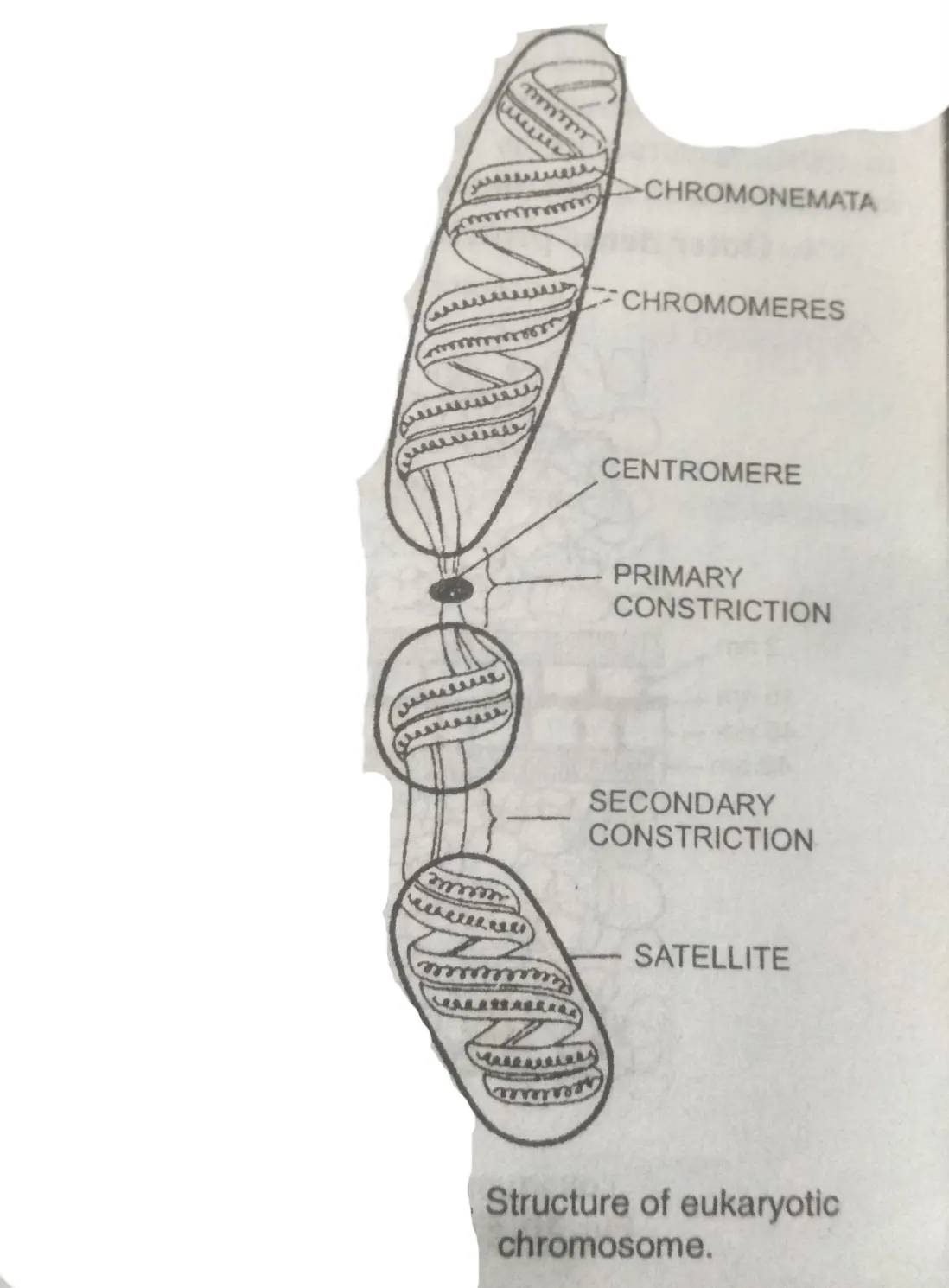Hello, guys, In today’s this article we will study about chromosomes. Like – what is chromosome? What are the functions of chromosomes, We will know the answers to many such questions today, so let’s start.
What is the definition of the Chromosome?
Definition of chromosome –
Chromosomes are described as vehicles of heredity materials. These contain genes arranged in a linear fashion. These are located in the nucleus of the year as darkly stated bodies during cell division, in the interphase nucleus for an interwoven net of fine chromatin threads.
The term chromosome was introduced by the world in Waldeyer 1888.
How many types of chromosomes?
- Viral chromosome
- Bacterial chromosome
- Eukaryotic chromosome
What is a Viral chromosome?
In viruses, a single molecule of DNA or RNA represents the chromosome. it may be linear or circular.
What is a Bacterial chromosome?
In bacteria and blue-green algae, the hereditary material DNA is organised into a single circular chromosome. It is formed of DNA alone without proteins.
What is the Eukaryotic chromosome?
In Eukaryotic cells, Chromosomes are formed of DNA and protein( nucleoprotein). in the interphase nucleus the interwoven network of Chromatin threads.
During cell division, the chromatin threads condense into a district of the darkly stained individualised protoplasmic body called chromosome (Waldeyer 1888).
Structure of Eukaryotic chromosome –
Shape –
The anaphase chromosome may appear as a rod Shaped twisted or spiral curved or filamentous. The chromosome may be of equal thickness throughout or constructed at places.
The shape of the chromosome is usually determined by the type and position of the centromere. Depending upon the position of the centromere the chromosomes in anaphase may assume the form of rod J or V.
Chromosome size –
The length of the chromosome varies from 0.2𝝻𝗺 to 50𝝻𝗺 and the diameter from 0.2 𝝻𝗺 to 3𝝻𝗺. In man, the length of different chromosomes varies from 4 𝝻𝗺 6 𝝻𝗺. the Giant chromosome in insects may be As Long as 800𝝻𝗺 and about 10𝝻𝗺 in width.
Number of chromosomes –
In the somatic cells of all higher plants and animals, the chromosome occurs in Pairs. The two chromosomes of a pair are called homologous chromosomes or homologous.
These are exactly similar in shape size and location to the centromere. Individuals with paired chromosomes are called diploid. Each cell of the body contains a diploid set of chromosomes (2n).
The gamete gametes have only one chromosome Of each type i.e. These have only one set of chromosomes and are called haploid.
The number of chromosomes Is constant for a species and is species-specific.
Structure of Chromosomes
Chromatids –
Metaphase chromosomes contain 2 fine threads like chromatids. The 2 chromatids of a Chromosome are identical and are called sister chromatids.
These remain attached to each other only at one point called the centromere. The centromere divides in anaphase and the sister chromatid separates out as an independent chromosome.
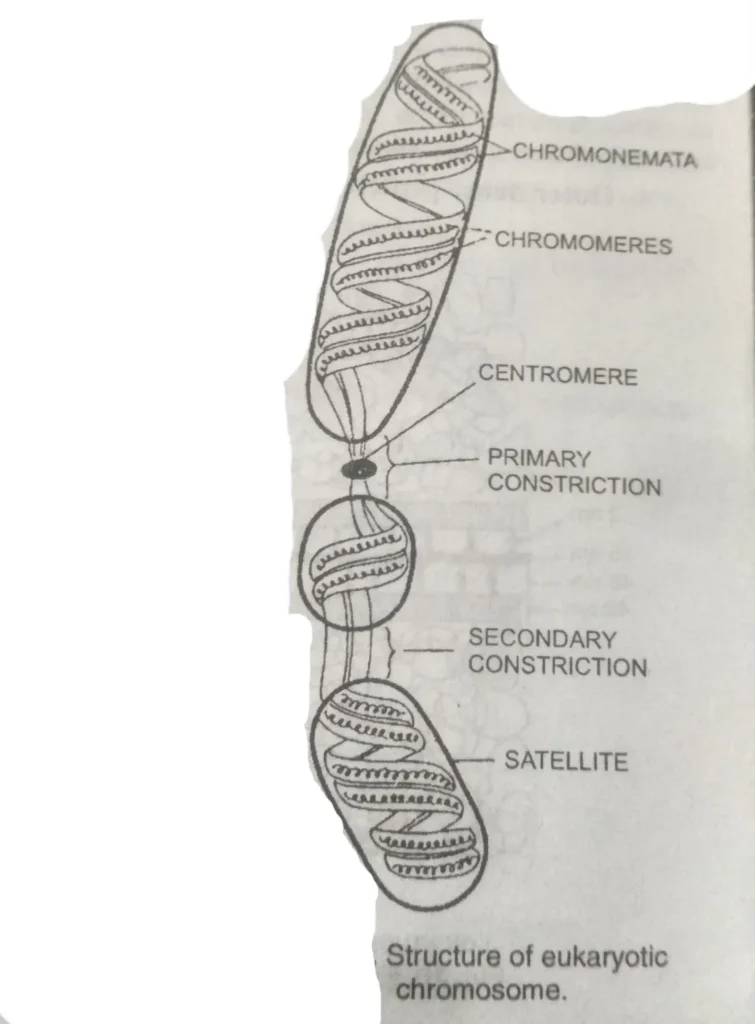
Chromonemata –
During prophase, the chromatin material appears as a very thin fibre. These are called Chromonemata( single chromonema).
These represent chromatids in the early stage of condensation. Each chromonema is a single DNA molecule with its associated proteins.
Chromomeres –
These are bead-like accumulations of chromatin material on chromonemata. These are visible in the leptotene zygotene and pachytene stages of prophase-I of meiosis when chromosomes have a beaded appearance.
Chromomeres are also visible as dark bands in polytene chromosomes. Chromosomes are tightly folded regions of DNA.
Regions in Eukaryotic chromosome –
Primary constriction and centromere (Kinetochore) –
At one point, each metaphase chromosome is narrow and appears constricted. It is known as primary constriction. Its position is constant for a given chromosome and is used as a feature of identification. Primary constriction divides the chromosomes into two arms.
Centromere lies in the region of primary constriction. It is a disc-shaped structure. It is the formula of specific DNA sequences and the special proteins bound to them. nearby is also called Kinetochore. If an electron microscope with the structure to a trilaminar structure.
outer dense Proteinaceous layer (Lateral element): 20-40 nm thick.
The middle layer or central element of low density – 15-50 nm thick and structureless.
The inner layer of dense material – 15-40 nm thick compact and has granule-like chromatin.
The dense inner layer is tightly bound to centromeric DNA. 4-40 microtubules of spindle fibres are attached to the kinetochore. Therefore Kinetochore provides the centre of assembly for microtubules and helps in coordinating the movement of chromosomes toward the pole of the spindle.
The region of primary constriction flanking the centromere contains highly repetitive DNA. It is heterochromatic and is called centromeric heterochromatin.
Types of chromosomes based on a number of centromeres
- Monocentric chromosomes with one centromere.
- Dicentric chromosome with two centromeres one in each chromatid.
- Polycentric chromosomes with more than 2 centromeres.
- Acentric chromosome without centromere. Such chromosomes represent a freshly broken segment of chromosomes that do not survive for long.
- Diffused or not located or holocentric chromosomes with indistinct centromere diffused throughout the length of the chromosome. The microtubules of spindle fibres are attached all along the length of the chromosome. The diffused centromeres are found in insects and some algae and some groups of plants e.g. Luzula.
Acentric and dicentric chromosomes are abnormally produced because of chromosomal aberrations.
Types of chromosomes based on the position of the centromere –
- Acrocentric are rod-shaped chromosomes with the centromere occupying a terminal position. One arm is very long and the other is absent.
- Telocentric are rod-shaped chromosomes having subterminal centromeres.
- The Submetacentric is an S-shaped chromosome with a centromere slightly away from the midpoint so that the two arms are unequal.
- Metacentric are V-shaped chromosomes in which the centromere lies in the middle of the chromosome so that the two arms are almost equal.
What are the Functions of Centromere –
The centromere is chromosomal and considered to perform the following two functions:
- Provides attachment for the microtubules of chromosomal spindle fibres and helps in chromosomal movement during cell division.
- Nucleation centre – The centromere serves as the nucleation centre for the polymerization of tubulin. The protein is used in the formation of microtubules. Thus it helps in the formation of spindle fibres during prometaphase.
Secondary constriction or Nuclear Organiser Region (NOR)
Sometimes one or both the arms of a chromosome are marked by a constriction other than the primary constriction. During interphase, this area is associated with the nucleolus and is found to partici[pate in the formation of the nucleolus.
It is, therefore, known as the nucleolar organiser region or the secondary construction. Its location on the chromosomes is marked with a lightly stained constricted region. Its location in the given chromosome is constant.
The nucleolar organiser region contains genes coding for 18S and 28S ribosomal RNA and is responsible for the formation of the nucleolus. It means the nucleolar organisers are located in the secondary constrictions of 13, 14, 15, 20, and 22 human chromosomes.
Tertiary Constrictions –
Tertiary constrictions are present in nearly all chromosomes. Their significance is not known. However, these help to distinguish one chromosome from others.
Telomeres –
The tips of the chromosomes are rounded and sealed and are called telomeres. These provide stability to the chromosome and protect their individuality. The broken ends of chromosomes become sticky and fuse with other broken ends whereas the telomeric ends do not fuse.
Satellite –
The terminal part of a chromosome beyond secondary constriction is called a satellite. It is attached to the main body of the chromosome by a delicate chromatin filament. The satellite may appear as a rounded or elongated knob. It has a constant shape and size for a particular chromosome. The chromosomes with satellite are known as sat chromosomes.
Chemical composition –
Each chromosome is formed by the folding and refolding of chromatin or a nucleoprotein fibre. It is formed of nucleic acids and proteins.
- Nucleic acids composing chromatin are (i) Deoxyribonucleic acid – 35% and (ii) Ribonucleic acid – 5% DNA is the hereditary material.
- Proteins are found in about 60% of a chromosome. These are –
- Acidic proteins or non-histone high molecular weight proteins act as enzymes.
- Basic proteins or low molecular weight proteins are histones. These are structural proteins that bind to DNA to form the nucleoprotein fibre. These are named H1, H2A, H2B, AND H4. These are responsible for the folding of DNA.
What are the functions of chromosomes?
- The chromosome controls the physiological or metabolic activities of the organism by controlling protein synthesis.
- Chromosomes control the development and differentiation of different characteristics of the organism.
- The heterochromatic region of chromosomes participates in the formation of the nucleolus.
- Changes in the number and structure of chromosomes lead to changes in the appearance of different characters.
- Repetitive DNA helps in the pairing of homologous chromosomes and crossing over during meiosis.
- Kinetochore helps in attaching the chromosome with the spindle fibre during cell division and helps in the movement of chromosomes during anaphase.
- Chromosomes are vehicles of hereditary materials.
What is the replication of chromosomes?
The fine structure of chromosomes repeats that a chromosome is formed of a single very long and coiled molecule of the double helix of DNA. The coils are held together in Association with proteins.
The application of chromosomes is actually the replication of DNA molecules. This is more evident from the fact that the DNA content of a cell that enters Cell division is just double of the daughter cells produced as a result of its division.
The replication of DNA involves first the uncoiling and separation of the strand of DNA molecule. The Separation is brought about by the breaking of hydrogen bonds between the base pairs.
Each of the separated strands then Picks up The complementary nitrogenous bases from the nucleoplasm.
For example, adenine (A) will pick up thymine (T) cytosine (C) will pair with guanine (G) guanine (G) with cytosine (C), and so on.
Let us say that the sequence in the newly formed strand will be AATCGGCT, then the base sequence in the newly formed strand will be TTAGCCGA.
These new base pairs are joined together by sugar and phosphoric acid molecules and complete the formation of a new complementary strand of DNA. In this way, each DNA molecule replicates its duplicate copy.
What is the number of chromosomes in humans?
The number of chromosomes in each cell of a human being is 46, which is a distinctive feature of the human race.
Which has the least number of chromosomes?
As far as chromosomes are concerned, the lowest number among animals is noted in Ascaris megalocephala, which has one pair i.e. two chromosomes, while the lowest number among plants is noted in Haplopappus gracilis.
Which has the maximum number of chromosomes?
The highest number of chromosomes in animals is noted in some radiolarian protozoa which is about 1600 chromosomes while in plants the highest number is noted in some Pteridophyta plants with about 1200 chromosomes.
Who discovered chromosomes?
The chromosome in the cell was discovered by scientist Walther Flemming and named chromosome by scientist Wilhelm Waldeyer.
Nucleosome model of chromosome structure –
According to the scientific R.D. Kornberg, each nucleosome is made up of DNA and a protein called histone. Nucleosomes contain five types of histone proteins H1, H2a, H2b, H3, and H4, except for H1, two each of the remaining four histone protein molecules (H2a, H2b, H3, H4) combine to form an octet. is, and around this histone octet, the DNA forms a coil of about two and a half helix. In which there are about 150 – 200 nucleotides.
A histone protein called H1 acts as a sealing by sticking to the top end of the bundled DNA. In addition to the above, that part of DNA that is located between two nucleosomes, that is, serves to connect nucleosomes, is called Linker DNA.
Gant Chromosome –
Under this, chromosomes of the huge size found in special cells of living beings come, these are chromosomes.
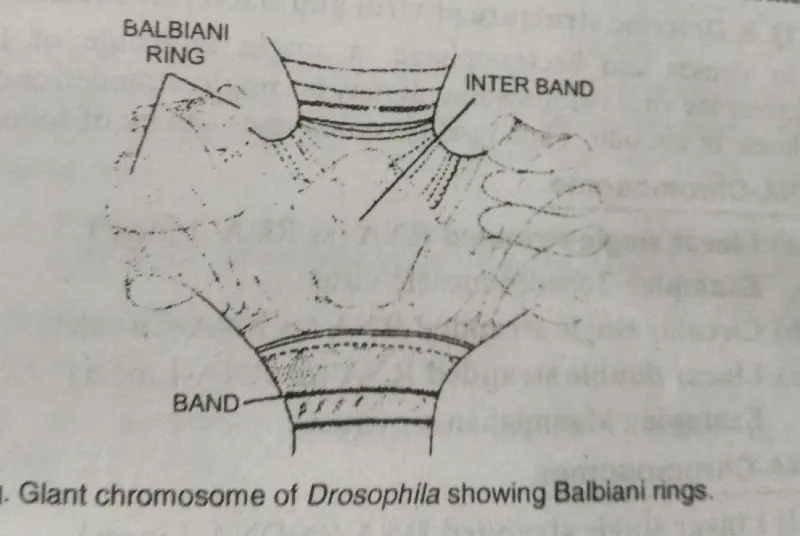
Lampbroosh chromosome –
These chromosomes are called lampbrush chromosomes because of their structure like a lamp cleaning brush in shape. They were discovered by scientist Ruckert in the year 1892.
These are the largest chromosomes found in the cell. And it is mainly found in the primary egg cells of birds etc.
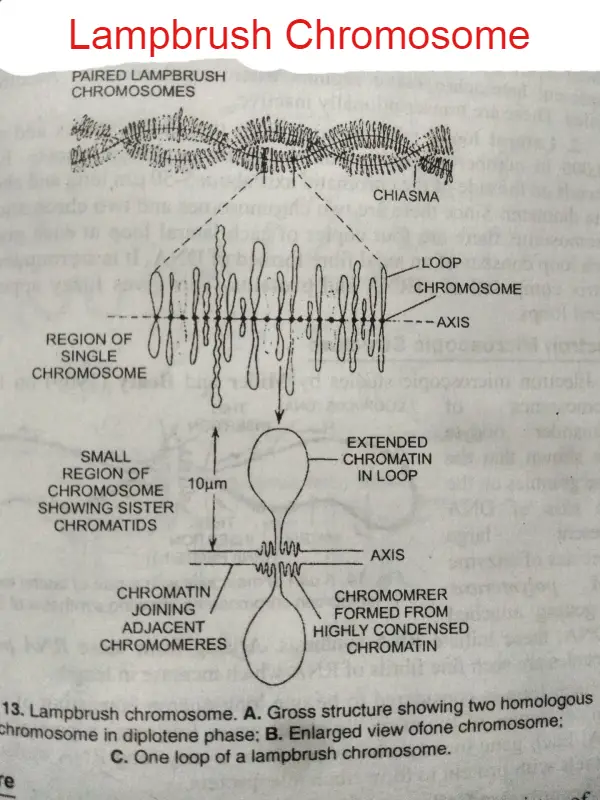
Each lampbrush chromosome has a centrosome axis. Due to this two loops made of two DNA emerge. The DNA of the loop is highly active and produces DNA by transcription.
This RNA takes part in protein synthesis. Hence, the Lampbruch chromosome is found in such cells. In which protein synthesis does not occur.
Polytene Chromosome –
These chromosomes are found in the insect salivary glands. Hence they are also called salivary chromosomes. Scientist E.G. Balbiani saw them in the large glands of Keto in 1881.
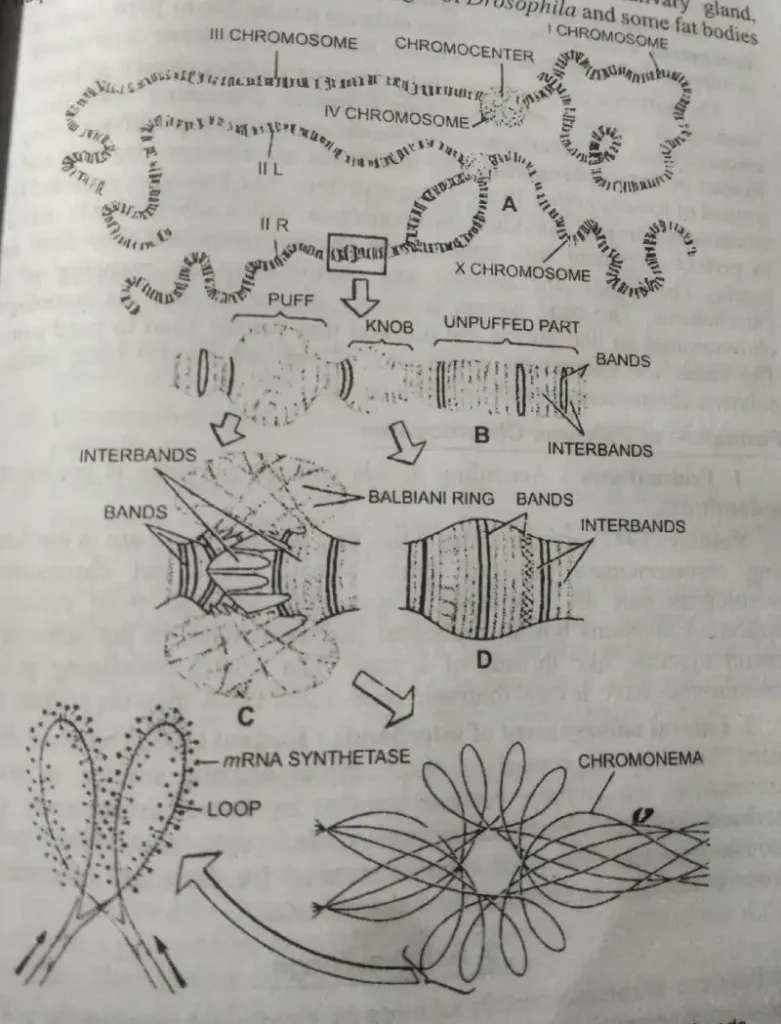
Each polytene chromosome is made up of structures called vend and inter vend. Polytene chromosomes swell at some places to form a ring-like structure called the Balbiani Ring or Balbianifupp.
So friends, in today’s article we have studied what is a chromosome. Friends, if you like this article, then please comment, share and tell your suggestions and our mistakes.
Thank you
